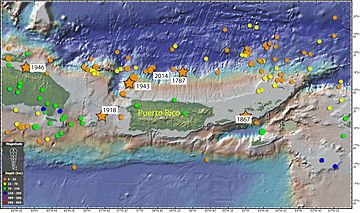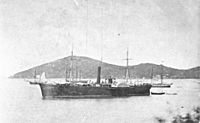1867 Virgin Islands earthquake and tsunami facts for kids

Map of earthquakes around Puerto Rico. The epicenter of the 1867 earthquake is marked in a star located on the right.
|
|
| UTC time | 1867-11-18 18:45:00 |
|---|---|
| 1868-03-17 11:15:00 | |
| USGS-ANSS | ComCat |
| ComCat | |
| Local date | 18 November 1867 |
| Local time | 14:45 |
| Magnitude | 7.5 Ms |
| Epicenter | 18°12′N 65°00′W / 18.2°N 65.0°W |
| Areas affected | Greater Antilles & Lesser Antilles |
| Total damage | Extensive |
| Max. intensity | IX (Devastating Tremor) |
| Tsunami | 18.3 m (60 ft) |
| Landslides | Possible |
| Aftershocks | 6.5 Mw |
| Casualties | >50–"hundreds" dead |
The 1867 Virgin Islands earthquake and tsunami occurred on November 18, at 2.45 p.m. in the Anegada Trough about 20 km southwest of Saint Thomas, Danish West Indies (now U.S. Virgin Islands). The Ms 7.5 earthquake came just 20 days after the devastating San Narciso Hurricane in the same region. Tsunamis from this earthquake were some of the highest ever recorded in the Lesser Antilles. Wave heights exceeded 10 m (33 ft) in some islands in the Lesser Antilles. The earthquake and tsunami resulted in no more than 50 fatalities, although casualties in the hundreds is also claimed.
Tectonic setting
The U.S.Virgin Islands are part of the Greater Antilles that lies parallel to the Puerto Rico Trench; an oblique subduction zone where the North American Plate is underthrusted beneath the Caribbean Plate along the Lesser Antilles subduction zone transits to strike-slip along the Septentrional-Oriente fault zone. Because of this transition, the overriding Caribbean Plate begins to extend, and normal faults starts to break out as a result. Subduction and shallow crustal faults pose earthquake and tsunami risk to the area, although the Lesser Antilles megathrust has not seen any major earthquake along its subduction interface. A possible earthquake along the megathrust may have been the Mw 8.3, 1843 Guadeloupe earthquake.
Earthquake
The earthquake consisted of two shocks, 10 minutes apart, and the two tsunamis came 10 minutes after each shock. Shaking reportedly lasted a minute in Frederiksted, where the earthquake stirred a dust cloud that blanketed the town. Shaking reached intensity IX on the Rossi–Forel scale in the Danish West Indies. Rossi–Forel IX-level shaking was also felt on the British Virgin Islands, Puerto Rico and U.S. Virgin Islands. Survivor accounts stated that there were two distinct shocks 10–15 minutes apart. On the Modified Mercalli intensity scale, the intensity ranged from VIII (Severe) to X (Extreme).
Tsunami
At Saint Thomas, the first wave was described as a "straight white wall, about 15 to 23 feet (4.6 to 7.0 meters)" which advanced to the harbor, 10 minutes after the earthquake. The wave picked up steamers along the way and broke to just a few feet in front of the town. The run-up height was 9.1 m (30 ft) across the town. A smaller wave came shortly and penetrated further in the island. Thirty people perished when the waves swept them away. Run-ups of 6.0 m (19.7 ft) were recorded at Charlotte Amalie, where 12 people died. The La Plata, a steamship serving the Royal Mail Steam Packet Company was swamped by the tsunami, killing nearly all of its crew onboard.
Little Saba saw the highest waves at 15.2 m (50 ft). A US Navy ship which had arrived the day before, the USS De Soto, was ripped from her moorings and beached. The second wave then brought the ship with her bottom seriously damaged back to sea.
At Christiansted, Saint Croix, the 7–9-meter waves drowned five people and inundated the island up to 90 meters inland. The tsunami destroyed 20 houses and stranded numerous boats inland. In some parts of the island, the waves reached a run-up height of 14.6 meters. Frederiksted on the same island was hit by waves up to 7.6 meters. The surging seawater beached many vessels including a US Navy ship, USS Monongahela along the beaches of Frederiksted. The tsunami waves were 12 meters on Water Island.
Meanwhile, at Road Town, British Virgin Islands, the waves were between 1.2 m (3 ft 11 in) and 1.5 m (4 ft 11 in) meters which swept away much of the low-lying towns. In Antigua, the sea level rose 2.4–3.0 m (7 ft 10 in – 9 ft 10 in) at Saint John harbor.
Eyewitnesses in Basse-Terre, Guadeloupe saw the sea receding and returning, flooding the place up to 2.0 m (6 ft 7 in). Deshayes was hit with very high waves, an estimated 18.3 m (60 ft) in height and a length of 5 km. The tsunami swept away many personal belongings and items. In Saint-Rose however, the waves were determined to be no more than 10.0 m (32.8 ft) when a church said to house fleeing survivors located 10 meters above sea-level remained undamaged.
In Puerto Rico, wave heights of 1–6 m (3 ft 3 in – 19 ft 8 in) meters swept through the island's coast. A parish church in Bayamón barrio-pueblo was damaged as a result of the earthquake.


